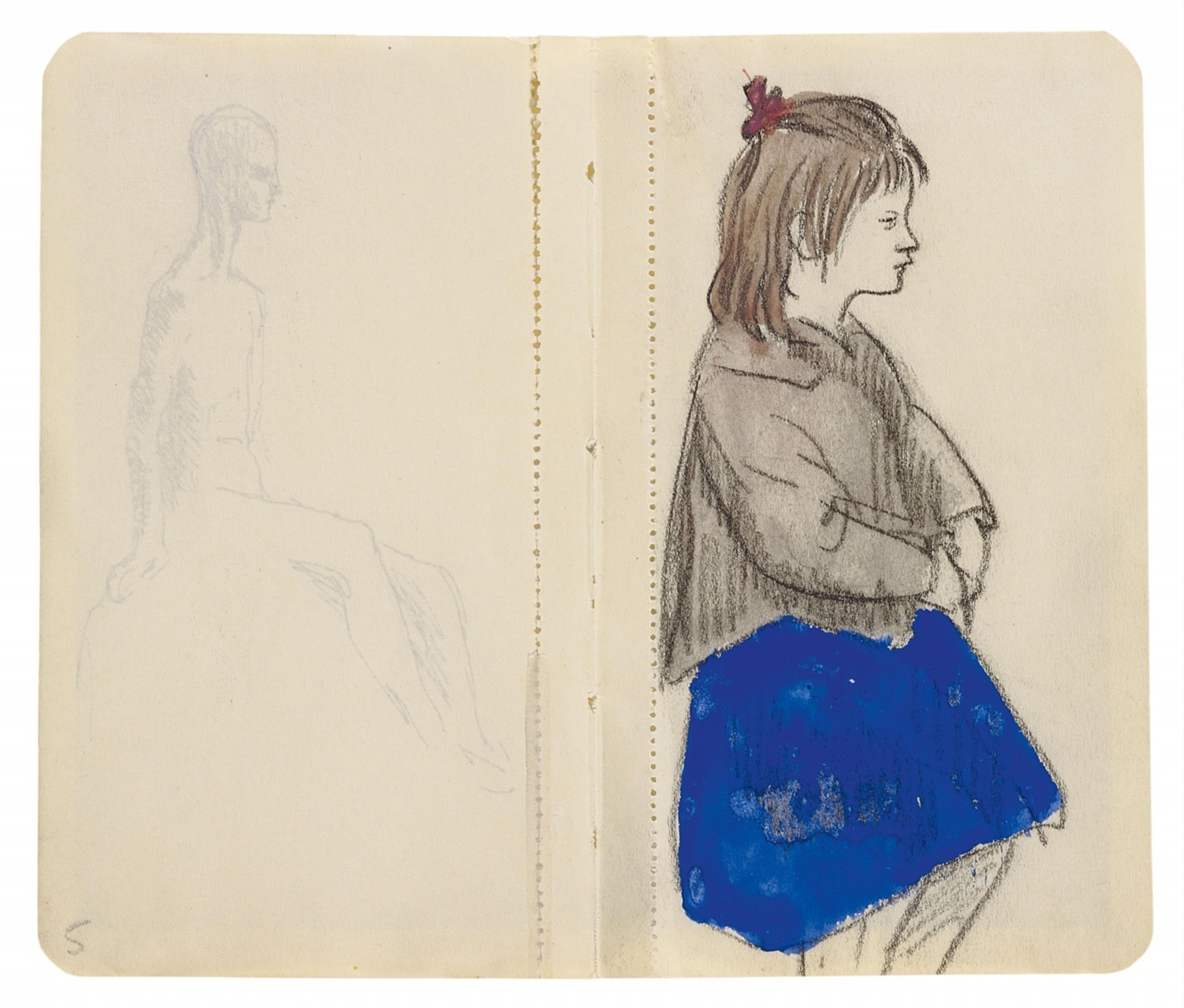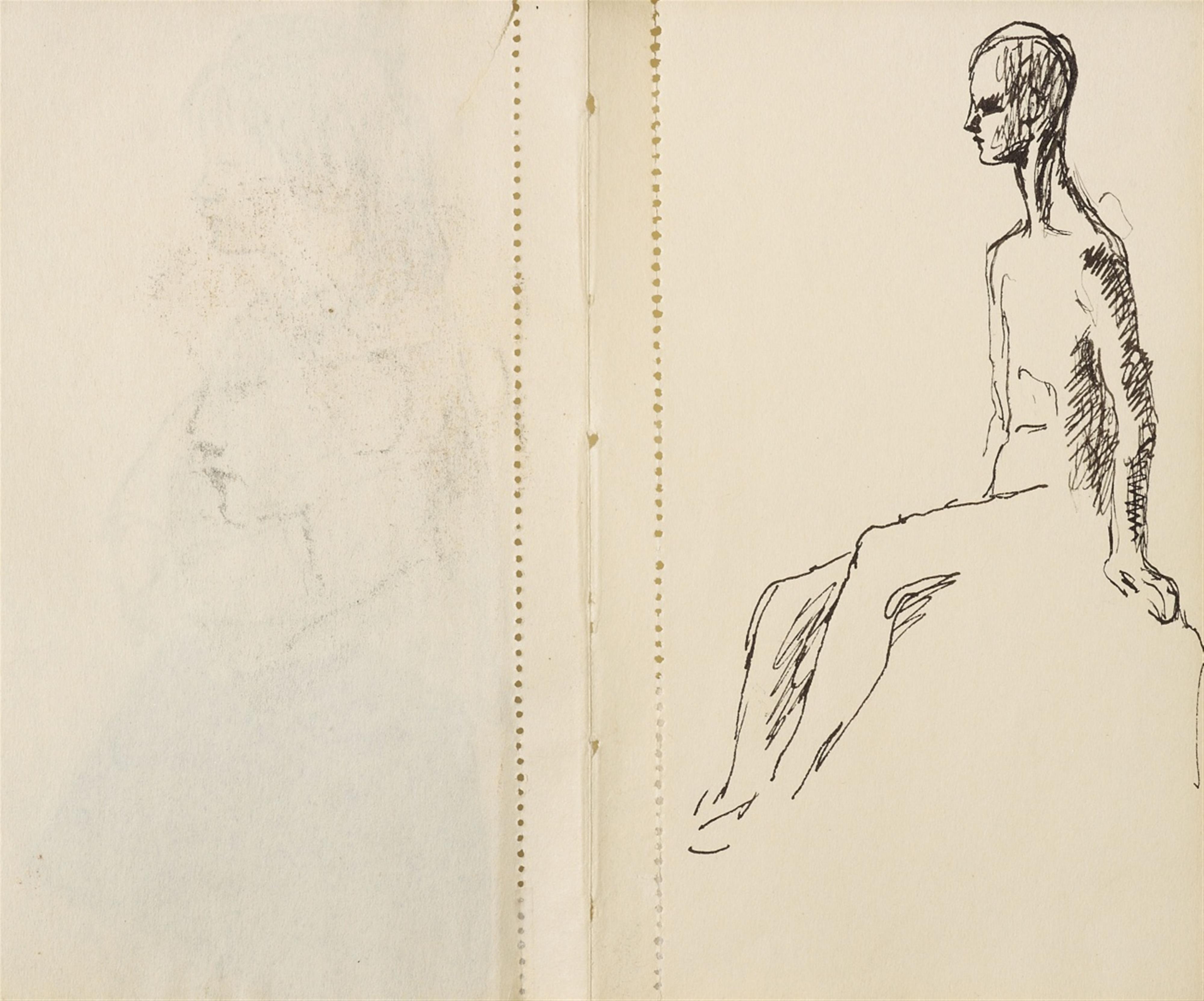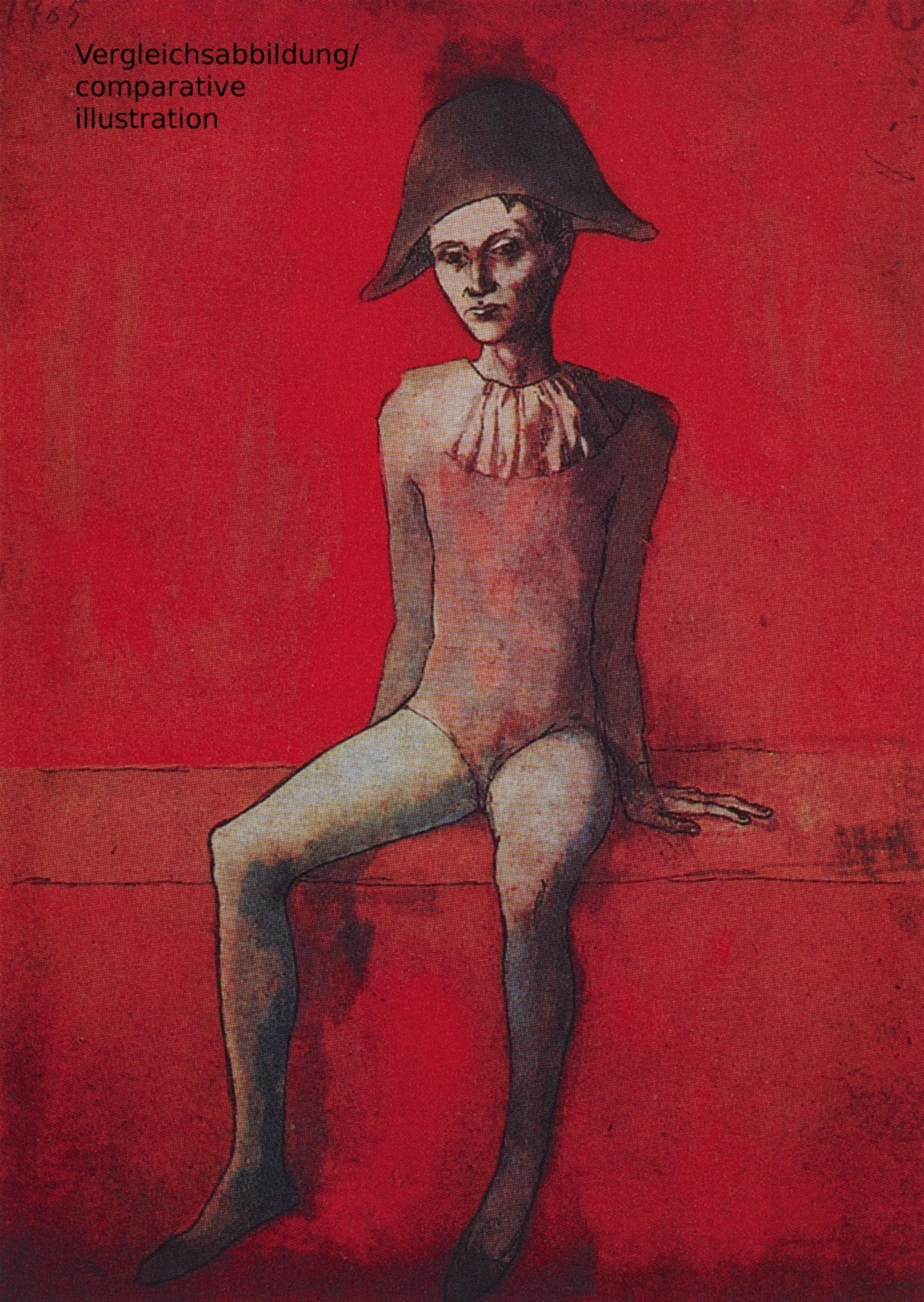Pablo Picasso
Jeune Fille. Verso: Étude pour Saltimbanque
1905
Watercolour, black and coloured chalks resp. pen and ink (recto and verso) on plain paper. The depictions each to the right on the double page of a sketchbook with rounded corners and perforation to the side margin Total dimensions including fold 14.4 x 16.9 cm (single sheet each approx. 14.4 x 7.5 cm) Framed from both sides under glass. Unsigned. - Inscribed "5" in pencil on the front left. Pages 5 and 10 of a carnet album by Pablo Picasso, Paris 1905 (Carnet 024). - The sheet with traces of the binding thread to the center, the perforation of the left slightly loose. - The margins of the page mounted to the mat on verso, the front exposed. - On the reverse of the carnet sheet the left side with the trace of a female head in profile facing left, with faint colouring.
The original sketchbook from Pablo Picasso's estate - a “pocket book” that can be dated to “3 de Mayo 1905” based on a note on one of the sheets - originally contained 51 pages. It was broken up, the present double page is part of it. The sketches and notes of this early sketchbook from 1905 are fascinating with regard to the theme of the “saltimbanques”, which featured motifs from the world of the circus and acrobats. These define Picasso's so-called Rose Period. Thus, the sketch of the slender youth seen in profile - one of the most beautiful from the sketchbook's series of six all around-studies of an elevated seated figure - recognisably prefigures what will return in the artist's paintings and prints of that year. In “Arlequin assis” we find not only the type but also the characteristic pose of the figure taken up once again (see comparative illus.).
Günter Metken wrote: “The year 1905 [...] is dominated by the theme of the acrobats. Several times a week Picasso and his friends went to the Cirque Médrano, at the foot of Montmartre, and chatted with the performers, sometimes inviting them over for a visit. The travelling circus people - who, like the artist, were without a home - define his compositions. [...] Their performances in front of alternating and merely suggested sceneries freed Picasso from the convention of having to conceive a solid pictorial space featuring accessory objects and local colour. His emphasis is on the pose and grouping of the figures, on their three-dimensional setup. [...] The first notations already attest to his distance from naturalism and genre: attentive looking and forming, no copying. They deal with a seated boy or youth, who is circled around as a 'sculpture'; in doing so, the anatomical details are less significant than the pose. The artist works very summarily from the model: abbreviation of forms, slender angularity and a somewhat asexual Gothic quality, which encompassed many of his figures following the revaluation of medieval art among his circle of friends in Barcelona. In the narrow head with its high forehead, the column-like neck, and the vertical - seemingly load-bearing - planting of the arms, we seem to sense the statics of a cathedral, at the same time, however, the bodily structure of early Greek figures of young men as well. Here Picasso practises riders' poses for the etching Die Wasserstelle (Geiser 10) [...]. In addition, the seated figure in the sketchbook can be typologically recognised in several famous works of this period, such as Akrobaten mit der Kugel, Akrobatenfamilie, Akrobat und junger Harlequin, etc. Each time, Picasso begins with the statuesque individual figures without relation to one another, and this provides these works with their composite character, held together only by the circus framework as a loosely binding element.” (Günter Metken, 3 de Mayo 1905: Ein Skizzenbuch aus der Rosa Periode, in: Pablo Picasso, Sammlung Marina Picasso, exhib. cat. Cologne 1981, pp. 36/37)
By contrast, the charming little girl with the finely drawn profile and the blue skirt, sheet 10 of the sketchbook, comes from a series of four drawings in colour, also in the sketchbook, a “portrait sequence with profile views of four different girls' figures” - admittedly there is no recognisable connection with the “saltimbanques”, but as a figurine it is related to them stylistically and in terms of expression (cf. E. A. Carmean Jr, Die Gaukler, Skizzenbuch Nr. 35 von 1905, in: Je suis le cahier, op. cit., p. 14). A comment from Fernande Olivier's memoirs about the Bateau-Lavoir may refer to this bold young model: “Pablo has brought back to the studio a young girl found I don't know where whom he is going to do as Joan of Arc. Bizarre-looking rather than beautiful with bright red hair and large, rather coarse but good features. She started posing two days ago. But last night I realized she must have been crawling with lice, as both of us have caught them.” (cited in Richardson, op. cit., p. 342) These lines could not more appropriately characterise Paris's creative bohemian community in those years.
Provenance
From the artist's estate; Collection of Marina Picasso; Galerie Jan Krugier, Ditesheim & Cie, Geneva (with labels to the frame); Private collection; Private possession, North Germany
Literature
Arnold Glimcher (ed.), Je suis le cahier. Die Skizzenbücher Pablo Picassos, New York 1986, with no. 5, illus. p. 23 and no. 10, colour illus. p. 26; cf. John Richardson, A Life of Picasso, New York 1991, vol. 1, p. 342; Sotheby's London, Pablo Picasso, Works from an important sketchbook of 1905, 8 Feb. 2006, lot 130 with colour illus.; Sotheby's London, Impressionist & Modern Art Day Sale, 9 Feb. 2011, lot 250 with colour illus.
Exhibitions
Venice 1981 (Centro di Cultura di Palazzo Grassi), Picasso, Opere dal 1895 al 1971 dalla Collezione Marina Picasso, cat. no. 49 ("Carnet 24"); Munich/ Colognen/ Frankfurt/Zurich 1981/1982 (Haus der Kunst/ Josef-Haubrich-Kunsthalle/ Städtische Galerie im Städelschen Kunstinstitut/Kunsthaus Zürich), Pablo Picasso, Sammlung Marina Picasso, cat. no. 43 ("Carnet 24"), illus. 5 and 10, p. 44; Tokyo/Kyoto 1983 (The National Museum of Modern Art Tokyo/ Kyoto Municipal Museum), Picasso, Masterpieces from Marina Picasso Collection and from Museums in U.S.A. and U.S.S.R., cat. no. 24 ("Sketchbook 24"), illus. 5 and 10, p. 183/ 184; Melbourne/Sydney 1984 (National Gallery of Victoria/Art Gallery of New South Wales), Picasso, cat. no. 169; London 1988 (The Lefevre Gallery), Picasso Works on Paper. Barcelona, Blue and Pink Periods from the Collection of Marina Picasso, cat. no. 20; New York 1989 (Jan Krugier Gallery), Picasso 'Petits formats'. Works from the Marina Picasso Collection, cat. no. 52; Barcelona/Bern 1992 (Museu Picasso/ Kunstmuseum Bern), Picasso 1905-1906, cat. no. 50 illus. and colour illus. p. 185; Berlin 1999 (Kupferstichkabinett - Staatliche Museen zu Berlin-Preussischer Kulturbesitz), Linie, Licht und Schatten, Meisterzeichnungen und Skulpturen der Sammlung Jan und Maire-Anne Krugier-Poniatowski, cat. no. 124 ; Geneva/ New York 2001/2002 (Galerie Jan Krugier, Ditesheim & Cie, Geneva/Jan Krugier Gallerry), Pablo Picasso Metamorphoses. Oeuvres de 1898 à 1973 de la Collection Marina Picasso






